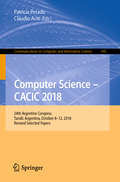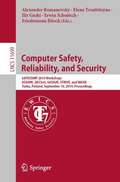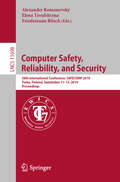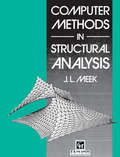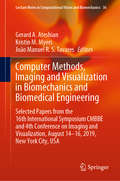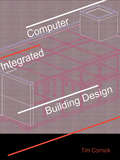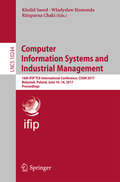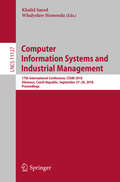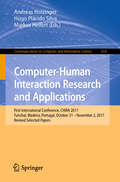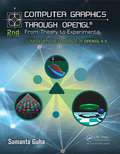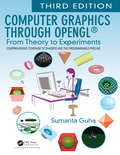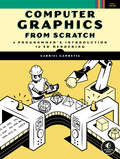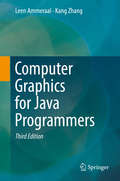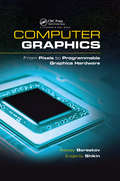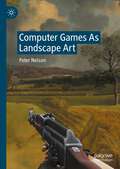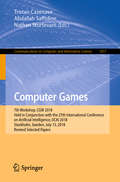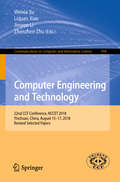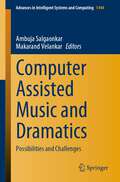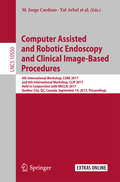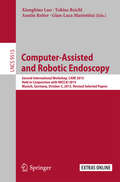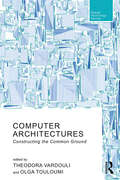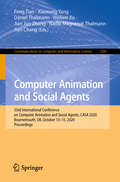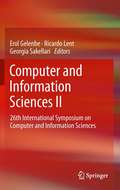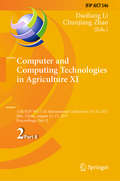- Table View
- List View
Computer Science – CACIC 2018: 24th Argentine Congress, Tandil, Argentina, October 8–12, 2018, Revised Selected Papers (Communications in Computer and Information Science #995)
by Patricia Pesado Claudio AcitiThis book constitutes revised selected papers from the 24th Argentine Congress on Computer Science, CACIC 2018, held in Tandil, Argentina, in October 2018. The 26 papers presented in this volume were carefully reviewed and selected from a total of 155 submissions. They were organized in topical sections named: Agents and Systems; Distributed and Parallel Processing; Technology Applied to Education; Graphic Computation, Images and Visualization; Software Engineering; Databases and Data Mining; Hardware Architectures, Networks, and Operating Systems; Innovation in Software Systems; Signal Processing and Real-Time Systems; Computer Security; Innovation in Computer Science Education; and Digital Governance and Smart Cities.
Computer Safety, Reliability, and Security: SAFECOMP 2019 Workshops, ASSURE, DECSoS, SASSUR, STRIVE, and WAISE, Turku, Finland, September 10, 2019, Proceedings (Lecture Notes in Computer Science #11699)
by Alexander Romanovsky Friedemann Bitsch Erwin Schoitsch Elena Troubitsyna Ilir GashiThis book constitutes the proceedings of the Workshops held in conjunction with SAFECOMP 2019, 38th International Conference on Computer Safety, Reliability and Security, in September 2019 in Turku, Finland. The 32 regular papers included in this volume were carefully reviewed and selected from 43 submissions; the book also contains two invited papers. The workshops included in this volume are: ASSURE 2019: 7th International Workshop on Assurance Cases for Software-Intensive Systems DECSoS 2019: 14th ERCIM/EWICS/ARTEMIS Workshop on Dependable Smart Embedded and Cyber-Physical Systems and Systems-of-Systems SASSUR 2019: 8th International Workshop on Next Generation of System Assurance Approaches for Safety-Critical Systems STRIVE 2019: Second International Workshop on Safety, securiTy, and pRivacy In automotiVe systEms WAISE 2019: Second International Workshop on Artificial Intelligence Safety Engineering
Computer Safety, Reliability, and Security: 38th International Conference, SAFECOMP 2019, Turku, Finland, September 11–13, 2019, Proceedings (Lecture Notes in Computer Science #11698)
by Alexander Romanovsky Elena Troubitsyna Friedemann BitschThis book constitutes the proceedings of the 38th International Conference on Computer Safety, Reliability and Security, SAFECOMP 2019, held in Turku, Finland, in September 2019. The 16 full and 5 short papers included in this volume were carefully reviewed and selected from 65 submissions. They were organized in topical sections named: formal verification; autonomous driving; safety and reliability modeling; security engineering and risk assessment; safety argumentation; verification and validation of autonomous systems; and interactive systems and design validation.
Computer Methods in Structural Analysis
by J.L. MeekThis book deals with finite element analysis of structures and will be of value to students of civil, structural and mechanical engineering at final year undergraduate and post-graduate level. Practising structural engineers and researchers will also find it useful. Authoritative and up-to-date, it provides a thorough grounding in matrix-tensor analysis and the underlying theory, and a logical development of its application to structures.
Computer Methods, Imaging and Visualization in Biomechanics and Biomedical Engineering: Selected Papers from the 16th International Symposium CMBBE and 4th Conference on Imaging and Visualization, August 14-16, 2019, New York City, USA (Lecture Notes in Computational Vision and Biomechanics #36)
by João Manuel R. S. Tavares Gerard A. Ateshian Kristin M. MyersThis book gathers selected, extended and revised contributions to the 16th International Symposium on Computer Methods in Biomechanics and Biomedical Engineering, and the 4th Conference on Imaging and Visualization (CMBBE 2019), held on August 14-16, 2019, in New York City, USA. It reports on cutting-edge models and algorithms for studying various tissues and organs in normal and pathological conditions; innovative imaging and visualization techniques; and the latest diagnostic tools. Further topics addressed include: numerical methods, machine learning approaches, FEM models, and high-resolution imaging and real-time visualization methods applied for biomedical purposes. Given the scope of its coverage, the book provides graduate students and researchers with a timely and insightful snapshot of the latest research and current challenges in biomedical engineering, computational biomechanics and biological imaging, as well as a source of inspiration for future research and cross-disciplinary collaborations.
Computer-Integrated Building Design
by Tim CornickComputer-Integrated Building Design is an accessible guide to the principles and applications of computer-integrated systems as applied to construction management. It describes current research, development and application of CAD related tools and techniques to the building design process and demonstrates the methods necessary to achieve knowledge-sharing in building design.
Computer Information Systems and Industrial Management: 16th IFIP TC8 International Conference, CISIM 2017, Bialystok, Poland, June 16-18, 2017, Proceedings (Lecture Notes in Computer Science #10244)
by Khalid Saeed Rituparna Chaki Władysław HomendaThis book constitutes the proceedings of the 15th IFIP TC8 International Conference on Computer Information Systems and Industrial Management, CISIM 2016, held in Vilnius, Lithuania, in September 2016. The 63 regular papers presented together with 1 inivted paper and 5 keynotes in this volume were carefully reviewed and selected from about 89 submissions. The main topics covered are rough set methods for big data analytics; images, visualization, classification; optimization, tuning; scheduling in manufacturing and other applications; algorithms; decisions; intelligent distributed systems; and biometrics, identification, security.
Computer Information Systems and Industrial Management: 17th International Conference, CISIM 2018, Olomouc, Czech Republic, September 27-29, 2018, Proceedings (Lecture Notes in Computer Science #11127)
by Khalid Saeed Władysław HomendaThis book constitutes the proceedings of the 17th International Conference on Computer Information Systems and Industrial Management Applications, CISIM 2018, held in Olomouc, Czech Republic, in September 2018. The 42 full papers presented together with 4 keynotes were carefully reviewed and selected from 69 submissions. The main topics covered by the chapters in this book are biometrics, security systems, multimedia, classification and clustering, and industrial management. Besides these, the reader will find interesting papers on computer information systems as applied to wireless networks, computer graphics, and intelligent systems. The papers are organized in the following topical sections: biometrics and pattern recognition applications; computer information systems; industrial management and other applications; machine learning and high performance computing; modelling and optimization; and various aspects of computer security.
Computer-Human Interaction Research and Applications: First International Conference, CHIRA 2017, Funchal, Madeira, Portugal, October 31 – November 2, 2017, Revised Selected Papers (Communications in Computer and Information Science #654)
by Andreas Holzinger Hugo Plácido Silva Markus HelfertThis book constitutes the refereed proceedings of the First International Conference on Computer-Human Interaction Research and Applications, CHIRA 2017, held in Funchal, Madeira, Portugal, in October/November 2017.The 8 full papers presented in this book were carefully reviewed and selected from 35 submissions. The papers selected to be included in this book contribute to the understanding of relevant trends of current research on computer-human interaction, including Interaction design, human factors, entertainment, cognition, perception, user-friendly software and systems, pervasive technologies and interactive devices.
Computer Graphics Through OpenGL: From Theory to Experiments
by Sumanta GuhaFrom geometric primitives to animation to 3D modeling to lighting, shading, and texturing, Computer Graphics Through OpenGL: From Theory to Experiments, Second Edition presents a comprehensive introduction to computer graphics that uses an active learning style to teach key concepts. Equally emphasizing theory and practice, the book provides an und
Computer Graphics Through OpenGL®: From Theory to Experiments
by Sumanta GuhaCOMPREHENSIVE COVERAGE OF SHADERS AND THE PROGRAMMABLE PIPELINE <P><P> From geometric primitives to animation to 3D modeling to lighting, shading and texturing, Computer Graphics Through OpenGL®: From Theory to Experiments is a comprehensive introduction to computer graphics which uses an active learning style to teach key concepts. Equally emphasizing theory and practice, the book provides an understanding not only of the principles of 3D computer graphics, but also the use of the OpenGL® Application Programming Interface (API) to code 3D scenes and animation, including games and movies. The undergraduate core of the book takes the student from zero knowledge of computer graphics to a mastery of the fundamental concepts with the ability to code applications using fourth-generation OpenGL®. The remaining chapters explore more advanced topics, including the structure of curves and surfaces, applications of projective spaces and transformations and the implementation of graphics pipelines. This book can be used for introductory undergraduate computer graphics courses over one to two semesters. The careful exposition style attempting to explain each concept in the simplest terms possible should appeal to the self-study student as well. <P><P> Features <br>• Covers the foundations of 3D computer graphics, including animation, visual techniques and 3D modeling• Comprehensive coverage of OpenGL® 4.x, including the GLSL and vertex, fragment, tessellation and geometry shaders• Includes 180 programs with 270 experiments based on them• Contains 750 exercises, 110 worked examples, and 700 four-color illustrations• Requires no previous knowledge of computer graphics• Balances theory with programming practice using a hands-on interactive approach to explain the underlying concepts
Computer Graphics from Scratch: A Programmer's Introduction to 3D Rendering
by Gabriel GambettaComputer Graphics from Scratch demystifies the algorithms used in modern graphics software and guides beginners through building photorealistic 3D renders.Computer graphics are at work everywhere today, adding eye-popping details to video games, hyper-realistic CGI to major blockbusters, and life-like imagery to computer-animated films. This beginners book will introduce you to a core slice of this ever-expanding field, 3D rendering, with a focus on two popular algorithmic methods: raytracing and rasterization. Written to be easily understood by high-school students but rigorous enough for professional engineers, you&’ll build each of these surprisingly simple algorithms into complete, fully functional renderers as you build your knowledge base. The first half covers raytracing, which simulates rays of light as they bounce off of objects in a scene; the second half breaks down rasterization, the real-time process for converting 3D graphics into a screen-compatible array of 2D pixels. Every chapter gives you something visually new and exciting to add to your works-in-progress, from creating reflections and shadows that make objects look more realistic, to rendering a scene from any directional point of view. You&’ll learn how to: • Represent objects in a scene, and use perspective projection to draw them in • Compute the illumination for light sources (point, directional, and ambient) • Render mirror-like reflections on surfaces, and cast shadows for depth • Use clipping algorithms to render a scene from any camera position • Implement flat shading, Gouraud shading, and Phong shading algorithms • "Paint&” textures that fake surface details and turn shapes into everyday objects The book uses informal pseudocode throughout the text, so you can write your renderers in any language. In addition, the author provides links to live working versions of his algorithms.
Computer Graphics for Java Programmers
by Leen Ammeraal Kang ZhangThis third edition covers fundamental concepts in creating and manipulating 2D and 3D graphical objects, including topics from classic graphics algorithms to color and shading models. It maintains the style of the two previous editions, teaching each graphics topic in a sequence of concepts, mathematics, algorithms, optimization techniques, and Java coding. Completely revised and updated according to years of classroom teaching, the third edition of this highly popular textbook contains a large number of ready-to-run Java programs and an algorithm animation and demonstration open-source software also in Java. It includes exercises and examples making it ideal for classroom use or self-study, and provides a perfect foundation for programming computer graphics using Java. Undergraduate and graduate students majoring specifically in computer science, computer engineering, electronic engineering, information systems, and related disciplines will use this textbook for their courses. Professionals and industrial practitioners who wish to learn and explore basic computer graphics techniques will also find this book a valuable resource.
Computer Graphics: From Pixels to Programmable Graphics Hardware (Chapman And Hall/crc Computer Graphics, Geometric Modeling, And Animation Ser. #3)
by Alexey Boreskov Evgeniy ShikinComplete Coverage of the Current Practice of Computer GraphicsComputer Graphics: From Pixels to Programmable Graphics Hardware explores all major areas of modern computer graphics, starting from basic mathematics and algorithms and concluding with OpenGL and real-time graphics. It gives students a firm foundation in today's high-performance graphic
Computer Games As Landscape Art
by Peter NelsonThis book proposes that computer games are the paradigmatic form of contemporary landscape and offers a synthesis of art history, geography, game studies and play. Like paint on canvas, the game engine is taken as the underlying medium, and using the Valve Source Engine as the primary case study, it analyses landscapes according to the technical, economic and cultural features this medium affords. It presents the single-player first-person shooter (Half-Life 2) as a Promethean safari, examines how the economics of gambling and product placement shaped the eSports landscapes of Counter-Strike and reveals how sandboxes such as Garry’s Mod visualise the radical landscape of Web 2.0. This book explores how our relationship to the environment is changing, how we express this through computer games and how we can move beyond examining artistic influences on games to examining how historical connections flow through games and the history of landscape images.
Computer Games: 7th Workshop, CGW 2018, Held in Conjunction with the 27th International Conference on Artificial Intelligence, IJCAI 2018, Stockholm, Sweden, July 13, 2018, Revised Selected Papers (Communications in Computer and Information Science #1017)
by Tristan Cazenave Abdallah Saffidine Nathan SturtevantThis book constitutes revised selected papers from the 7th Workshop on Computer Games, CGW 2018, held in conjunction with the 27th International Conference on Artificial Intelligence, IJCAI 2018 in Stockholm, Sweden, in July 2018.The 8 full papers presented in this volume were carefully reviewed and selected from 15 submissions. They cover a wide range of topics related to video games; general game playing.- machine learning and Monte Carlo tree search.
Computer Engineering and Technology: 22nd CCF Conference, NCCET 2018, Yinchuan, China, August 15–17, 2018, Revised Selected Papers (Communications in Computer and Information Science #994)
by Weixia Xu Liquan Xiao Jinwen Li Zhenzhen ZhuThis book constitutes the refereed proceedings of the 22nd CCF Conference on Computer Engineering and Technology, NCCET 2018, held in Yinchuan, China, in August 2018.The 17 full papers presented were carefully reviewed and selected from 120 submissions. They address topics such as processor architecture; application specific processors; computer application and software optimization; technology on the horizon.
Computer Assisted Music and Dramatics: Possibilities and Challenges (Advances in Intelligent Systems and Computing #1444)
by Ambuja Salgaonkar Makarand VelankarThis book is intended for researchers interested in using computational methods and tools to engage with music, dance and theatre. The chapters have evolved out of presentations and deliberations at an international workshop entitled Computer Assisted Music and Dramatics: Possibilities and Challenges organized by University of Mumbai in honour of Professor Hari Sahasrabuddhe, a renowned educator and a pioneering computational musicologist (CM) of Indian classical music. The workshop included contributions from CM as well as musicians with a special focus on South Asian arts. The case studies and reflective essays here are based on analyses of genres, practices and theoretical constructs modelled computationally. They offer a balanced and complementary perspective to help innovation in the synthesis of music by extracting information from recorded performances. This material would be of interest to scholars of the sciences and humanities and facilitate exchanges and generation of ideas.
Computer Assisted and Robotic Endoscopy and Clinical Image-Based Procedures
by M. Jorge Cardoso Tal Arbel Xiongbiao Luo Stefan Wesarg Tobias Reichl Miguel Ángel González Ballester Klaus Drechsler Terry Peters Marius Erdt Kensaku Mori Marius George Linguraru Andreas Uhl Cristina Oyarzun Laura Raj Shekhar Jonathan McLeodThis book constitutes the refereed joint proceedings of the 4th International Workshop on Computer Assisted and Robotic Endoscopy, CARE 2017, and the 6th International Workshop on Clinical Image-Based Procedures: Translational Research in Medical Imaging, CLIP 2017, held in conjunction with the 20th International Conference on Medical Imaging and Computer-Assisted Intervention, MICCAI 2017, in Québec City, QC, Canada, in September 2017. The 7 full papers presented at CARE 2017 and the 10 full papers presented at CLIP 2017 were carefully reviewed and selected. The papers deal with interventional and diagnostic endoscopy integrating the latest advances in computer vision, robotics, medical imaging and information processing and the development and evaluation of new translational image-based techniques in the modern hospital.
Computer-Assisted and Robotic Endoscopy: Second International Workshop, CARE 2015, Held in Conjunction with MICCAI 2015, Munich, Germany, October 5, 2015, Revised Selected Papers (Lecture Notes in Computer Science #9515)
by Xiongbiao Luo Tobias Reichl Austin Reiter Gian-Luca MariottiniThis book constitutes the thoroughly refereedpost-conference proceedings of the Second International Workshop on ComputerAssisted and Robotic Endoscopy, CARE 2015, held in conjunction with MICCAI2015, in Munich, Germany, in October 2015. The 15 revised full papers were carefully selected out of20 initial submissions and focus on recent technical advances associated withcomputer vision; graphics; robotics and medical imaging; external trackingsystems; medical device control systems; information processing techniques;endoscopy; planning and simulation.
Computer Architectures: Constructing the Common Ground (Routledge Research in Design, Technology and Society)
by Theodora Vardouli Olga TouloumiComputer Architectures is a collection of multidisciplinary historical works unearthing sites, concepts, and concerns that catalyzed the cross-contamination of computers and architecture in the mid-20th century. Weaving together intellectual, social, cultural, and material histories, this book paints the landscape that brought computing into the imagination, production, and management of the built environment, whilst foregrounding the impact of architecture in shaping technological development. The book is organized into sections corresponding to the classic von Neumann diagram for computer architecture: program (control unit), storage (memory), input/output and computation (arithmetic/logic unit), each acting as a quasi-material category for parsing debates among architects, engineers, mathematicians, and technologists. Collectively, authors bring forth the striking homologies between a computer program and an architectural program, a wall and an interface, computer memory and storage architectures, structures of mathematics and structures of things. The collection initiates new histories of knowledge and technology production that turn an eye toward disciplinary fusions and their institutional and intellectual drives. Constructing the common ground between design and computing, this collection addresses audiences working at the nexus of design, technology, and society, including historians and practitioners of design and architecture, science and technology scholars, and media studies scholars.
Computer Animation (Kaleidoscope)
by Darcy LockmanExplains how computer animation is used to make entire films, indicates how it differs from traditional animation, and includes information on the development of that technology.
Computer Animation and Social Agents: 33rd International Conference on Computer Animation and Social Agents, CASA 2020, Bournemouth, UK, October 13-15, 2020, Proceedings (Communications in Computer and Information Science #1300)
by Feng Tian Xiaosong Yang Daniel Thalmann Weiwei Xu Jian Jun Zhang Nadia Magnenat Thalmann Jian ChangThis book constitutes the revised selected papers of the 33rd International Conference on Computer Animation and Social Agents, CASA 2020, held in Bournemouth, UK*, in October 2020.The 1 full paper and 13 short papers presented were carefully reviewed and selected from a total of 86 submissions. The papers are organized in topical sections of modelling, animation and simulation; virtual reality; image processing and computer vision.*The conference was held virtually due to the COVID-19 pandemic.
Computer and Information Sciences II: 26th International Symposium on Computer and Information Sciences
by Erol Gelenbe Ricardo Lent Georgia SakellariInformation technology is the enabling foundation for all of human activity at the beginning of the 21st century, and advances in this area are crucial to all of us. These advances are taking place all over the world and can only be followed and perceived when researchers from all over the world assemble, and exchange their ideas in conferences such as the one presented in this proceedings volume regarding the 26th International Symposium on Computer and Information Systems, held at the Royal Society in London on 26th to 28th September 2011. Computer and Information Sciences II contains novel advances in the state of the art covering applied research in electrical and computer engineering and computer science, across the broad area of information technology. It provides access to the main innovative activities in research across the world, and points to the results obtained recently by some of the most active teams in both Europe and Asia.
Computer and Computing Technologies in Agriculture XI: 11th IFIP WG 5.14 International Conference, CCTA 2017, Jilin, China, August 12-15, 2017, Proceedings, Part II (IFIP Advances in Information and Communication Technology #546)
by Daoliang Li Chunjiang ZhaoThe two volumes IFIP AICT 545 and 546 constitute the refereed post-conference proceedings of the 11th IFIP WG 5.14 International Conference on Computer and Computing Technologies in Agriculture, CCTA 2017, held in Jilin, China, in August 2017.The 100 revised papers included in the two volumes were carefully reviewed and selected from 282 submissions. They cover a wide range of interesting theories and applications of information technology in agriculture. The papers focus on four topics: Internet of Things and big data in agriculture, precision agriculture and agricultural robots, agricultural information services, and animal and plant phenotyping for agriculture.
